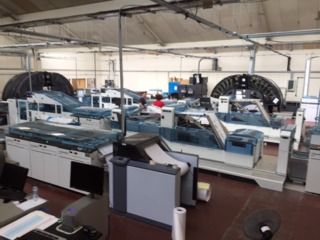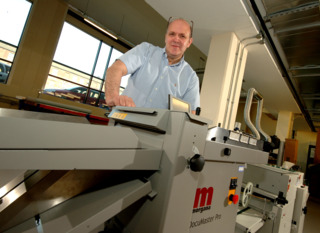Can’t Touch This
The difference between in-line, near-line, and off-line finishing is all in the handling of the printed product – or not.

There’s no “one size fits all” when it comes to selecting a finishing solution. Not all print service providers (PSPs) will benefit from in-line finishing procedures and not all PSPs will benefit from off-line, either. The focus is achieving a lean production process for the type of printing being done.
“The decision to go with one over the other depends almost entirely on the type and conditions of each specific work environment,” noted Ryan Manieri, marketing manager, MBO America. "The pros and cons are not particularly affected by digital or offset technologies. The bigger consideration is in the variety of the work. For example, if a printer is always running presentation folders, an inline solution might be best because the jobs are always the same.”
Marieri says it doesn’t matter whether the presentation folders are printed digitally or offset. However, if the printer is doing presentation folders one day, folding cartons another, and direct mail after that, a near-line/off-line solution would likely be the better fit.
“This is because inline finishing works best when it is fine-tuned for one particular production type, while modular near-line/off-line systems offer tremendous production flexibility,” Manieri noted.
Offset vs. Digital Printing Needs
Traditionally, offset printers have managed finishing processes offline, due to the serial nature of production.
In the offset industry, inline configurations with integrated components for additional product applications are the standard, states Alwin Stadler, vice president of digital for manroland web systems. “We are realizing that trend in digital printing systems as well, with increasing frequency, as print speeds in digital printing rise,” he said.
Morgana points out that publications generally do not lend themselves to inline work with offset due to the nature of the process. Digital, however, Morgana says, changes the picture. Digital engines are able to produce all of the pages of a single publication before moving onto the next copy. These pre-collated pages lend themselves to immediate binding in-line.
Joe Bondonn, product manager, Spiral Binding echoes this sentiment. “Offset printing generally does not have in-line finishing options, so off-line is the only choice available and is still the best method for printing large production jobs,” he explained. “It will be interesting to see if the large web press inkjet digital systems will truly take over the offset printing market.”
“Due to the fact that digital printing utilizes variable printing and batching of SKU’s very differently, the management of the converting and finishing inline carries different dynamics,” offered Roy Oomen, labels & packaging category manager, HP Inc. “In general, a digital press will undergo many more set ups during a shift of work, and the set up for finishing becomes prohibitive in some cases to keep the line productive. In many cases a finishing device can also keep up with the output of two or even three digital presses; for instance, in the case of solvent free laminating. As a result, keeping finishing off-line is by far the most capital effective method to manage one’s investments for equipment. The fact that digital presses tend to attract a very wide variety of jobs and applications, and a great amount of variety in substrates, carries implications for how finishing is managed for digital printing, opposed to traditional offset technologies.”
In the past 2 years, manroland web systems have installed about 20 new systems in different market places and applications (book printing, newsprint, and commercial). Especially this year, all of them are in-line configurations in combination with high-speed printing systems. “This is an indication of the trend toward highly flexible and highly automated finishing for what would traditionally be considered industrial high volume print operations,” explained Stadler.
In-Line vs Off-Line
The biggest pros to in-line finishing are automation for ease of operation and minimal touchpoints for greater workflow efficiency, creating a “roll to end-product” production line. It requires minimal experience to operate and the entire process from print to finish can be managed by a single operator. When it comes to off-line, there is a faster processing speed; it does not connect to the printer and does not impede the printing process. It also can support output from multiple engines.
Manieri says he hasn’t really noticed a particular “trend” towards one or the other. “The idea isn’t “inline vs offline”, where one is pushing out the other of the market, as both processes are extremely relevant,” he commented.
Customers often switch to in-line systems hoping to streamline their operation, but then look back to off-line automated finishing when their lease on the former system ends, explains, Bondonna. As competition for printing grows and margins shrink, he notes that adding finishing is an opportunity to increase sales and profit margins, which is why more PSPs continue to bring print finishing in-house. “It also provides better control of jobs compared to outsourcing and makes printers a more valuable resource for their customers,” he said.
According to Don Dubuque, director of marketing, Standard Finishing, flexibility and investment protection are driving factors in the decision process when evaluating whether to configure systems in-line or off-line. “One interesting trend is towards systems that can operate either in-line and off-line to accommodate both roll-fed and sheet-fed jobs,” Dubuque said. “One such example is Standard’s Roll-to-Fold system, which can be changed over from in-line to off-line folding in just minutes, providing the flexibility to efficiently handle jobs from multiple print sources. The system can go from white paper roll all the way to finished folded output in a single pass with no manual intervention. Or, the folder can be used off-line as a stand-alone device for processing cut-sheet work.”
Omen says the trend in the market for digital labels and packaging is definitely for near line finishing. “The great majority of finishing interfaces with HP Indigo digital presses offer the best of both worlds: Run in-line, when it makes sense; run off-line when many set ups downstream can intervene with digital press productivity. Most importantly, the ability to adjust quickly is the most important aspect, as production needs can change rapidly in a digital production environment. This is, of course, due to the nature of the type of jobs which digital printing attracts more variable data, more changes etc.”
Morgana Systems says it tends to focus on near-line and off-line finishing solutions. “The biggest pro for inline is surely the immediacy of finishing, with prints moving straight from one process to the next with no human intervention,” the company said. “However, the offline solution will allow the finishing of work from more than one print engine, allowing those engines to print at full speed. When conducting more intricate finishing processes inline the speed of the print engine can be compromised.”
Bondonna says the biggest advantage of in-line finishing is the reduced touches required during job processing, which saves time in getting jobs finished. However, he states, in-line finishing limits the type of finishing on that specific print engine. “It eliminates the ability to merge materials from different prints sources to offer customers more options. It can also translate to higher costs for the print, specifically if a different print type is a more economical way to run a job,” Bondonna explained. “Lastly, if there is an issue with down time on the in-line system, all operations stop, while off-line finishing jobs can be moved and continue to be produced.”
When a PSP is deciding between in-line or off-line (near-line) finishing, it’s important to consider run-length and job mix, says Dubuque, which drive the number of finishing changeovers required per shift. “In-line finishing can make sense if you have just one or two applications that you run the majority of the time, so the job can run from white paper roll to finished product in one continuous path with less human intervention and potentially lower labor costs. Near-line finishing configuration, running roll-to-roll or roll-to-cut on the press, then performing downstream finishing separately, provides increased flexibility, and one productive off-line system can sometimes finish product from multiple presses. When you tie all processes together into one line, you run the risk that if one element is down, the whole system stops, impacting overall productivity. Operating off-line, it’s a plus that press and finishing speeds can be dialed up or down as needed. Given inkjet’s unique ability to handle very lightweight substrates, you may want to finish slower than you print to obtain better quality. In other cases, the press may actually outrun the finisher and PSP’s want to keep the printer running at maximum speed. Keep in mind, offline systems don’t depend on each other; if the press is down, the finisher can continue to produce and vice versa. On the flip side, off-line finishing requires more manual touch points and more time, which increases labor costs and can decrease efficiency. The in-line/off-line debate is complex and there’s no one right approach.”
There is no one type of finishing that works with a specific job, explains Bondonna. “The key to document finishing is to make your product stand out. With so many options today, even in short run jobs, customers are only limited by their imagination and maybe sometimes by their budget.”





